Spatiotemporal Evolution of Precipitation Heterogeneity Characteristics in the Heilongjiang Province from 1961 to 2020
Abstract
:1. Introduction
2. Materials and Methods
2.1. Study Region
2.2. Methods
2.2.1. Method for Calculating PCI
2.2.2. PCD and PCP Calculations
2.2.3. MK Trend Test
3. Result and Discussions
3.1. Spatial Pattern of PCI at Different Timescales
3.2. Spatial Distribution of PCI Trends at Different Timescales
3.3. Spatial Patterns of PCD at Different Timescales
3.4. Spatial Patterns of PCP at Different Timescales
3.5. Interpretation of the Precipitation Unevenness
4. Conclusions
- (1)
- At the three scales of year, growth period, and growth stage, the PCI values in southwestern Heilongjiang Province are higher, while the areas with lower values are more scattered. This indicates that precipitation in southwestern Heilongjiang Province is more concentrated, corresponding to fewer rainy days on a given timescale.
- (2)
- At the three scales of year, growth period, and growth period, the PCD shows a decreasing trend from west to east. On an annual scale, precipitation in the western part of Heilongjiang Province is relatively concentrated and occurs relatively early, while precipitation in the eastern part is scattered and concentrated later. Precipitation displays uneven distribution in both space and time. While the overall trend of precipitation at the growth period scale remains unchanged compared with the annual scale, the overall precipitation concentration is lower, and precipitation is relatively evenly distributed. In each stage of the growth period, the largest PCD values appear in the Qiqihar and Daqing areas, while the smallest value appears in the Mudanjiang area.
- (3)
- On the annual scale, the spatial distribution of PCP is high in the northeast and northwest and low in the southwest and central parts. The PCP decreases from 203° to 196°, indicating that the annual precipitation concentration period in the southwest and central parts of Heilongjiang Province is earlier than that in the northeast. In the central and northwest regions, the annual precipitation is mainly concentrated in July. The PCP decreases from 203° to 188° at the growth period scale, indicating that the growth period precipitation occurs earlier in the southwest and central Heilongjiang Province than in the northeast and northwest, and the precipitation during the growth period is mainly concentrated in mid- and late July. The distribution of PCP in each growth stage is quite different, but the PCP values are concentrated in the range of 129°~241°, indicating that precipitation in each growth stage is concentrated in the middle of each growth stage.
Author Contributions
Funding
Data Availability Statement
Conflicts of Interest
References
- Molua, E.L. An empirical assessment of the impact of climate change on smallholder agriculture in Cameroon. Glob. Planet. Change 2009, 67, 205–208. [Google Scholar] [CrossRef]
- Sohoulande, C.D.D.; Stone, K.; Szogi, A.; Bauer, P. An investigation of seasonal precipitation patterns for rainfed agriculture in the Southeastern region of the United States. Agric. Water Manag. 2019, 223, 105728. [Google Scholar] [CrossRef]
- Zhang, Q.; Sun, P.; Singh, V.P.; Chen, X.H. Spatial-temporal precipitation changes (1956–2000) and their implications for agriculture in China. Glob. Planet. Change 2012, 82–83, 86–95. [Google Scholar] [CrossRef]
- Wang, T.Y.; Du, C.; Nie, T.Z.; Sun, Z.Y.; Zhu, S.J.; Feng, C.X.; Dai, C.L.; Chu, L.L.; Liu, Y.; Liang, Q.Z. Spatiotemporal analysis of maize water requirement in the Heilongjiang Province of China during 1960–2015. Water 2020, 12, 2472. [Google Scholar] [CrossRef]
- Piao, S.L.; Ciais, P.; Huang, Y.; Shen, Z.H.; Peng, S.S.; Li, J.S.; Zhou, L.P.; Liu, H.Y.; Ma, Y.C.; Ding, Y.H.; et al. The impacts of climate change on water resources and agriculture in China. Nature 2010, 467, 43–51. [Google Scholar] [CrossRef] [PubMed]
- Pendergrass, A.G.; Knutti, R.; Lehner, F.; Deser, C.; Sanderson, B.M. Precipitation variability increases in a warmer climate. Sci. Rep. 2017, 7, 17966. [Google Scholar] [CrossRef] [PubMed]
- He, B.R.; Zhai, P.M. Changes in persistent and non-persistent extreme precipitation in China from 1961 to 2016. Adv. Clim. Change Res. 2018, 9, 177–184. [Google Scholar] [CrossRef]
- Yang, X.J.; Xu, Z.X.; Liu, W.F.; Liu, L. Spatiotemporal characteristics of extreme precipitation at multiple timescales over Northeast China during 1961–2014. J. Water Clim. Change 2017, 8, 535–556. [Google Scholar] [CrossRef]
- Huang, H.P.; Winter, J.M.; Osterberg, E.C.; Horton, R.M.; Beckage, B. Total and extreme precipitation changes over the Northeastern United. J. Hydrometeorol. 2017, 18, 1783–1798. [Google Scholar] [CrossRef]
- Zhang, L.J.; Li, Y.S.; Zhang, F.; Chen, L.; Pan, T.; Wang, B.; Ren, C. Changes of winter extreme precipitation in Heilongjiang province and the diagnostic analysis of its circulation features. Atmos. Res. 2020, 245, 105094. [Google Scholar] [CrossRef]
- O’Gorman, P.A. Precipitation extremes under climate change. Curr. Clim. Change Rep. 2015, 1, 49–59. [Google Scholar] [CrossRef]
- Huang, Y.; Wang, H.; Xiao, W.H.; Chen, L.H.; Yang, H. Spatiotemporal characteristics of precipitation concentration and the possible links of precipitation to monsoons in China from 1960 to 2015. Theor. Appl. Climatol. 2019, 138, 135–152. [Google Scholar] [CrossRef]
- Zhang, R.; Li, A.Q.; Chen, T.T.; Xia, G.M.; Wu, Q.; Chi, D.C. Analysis of precipitation concentration degree changes and its spatial evolution in the western plain of Jilin Province. Mausam 2020, 71, 291–298. [Google Scholar]
- Amiri, M.A.; Gocic, M. Analyzing the applicability of some precipitation concentration indices over Serbia. Theor. Appl. Climatol. 2021, 146, 645–656. [Google Scholar] [CrossRef]
- Chatterjee, S.; Khan, A.; Akbari, H.; Wang, Y.P. Monotonic trends in spatio-temporal distribution and concentration of monsoon precipitation (1901–2002), West Bengal, India. Atmos. Res. 2016, 182, 54–75. [Google Scholar] [CrossRef]
- Silva, B.K.N.; Lucio, P.S. Characterization of risk/exposure to climate extremes for the Brazilian Northeast-case study: Rio Grande do Norte. Theor. Appl. Climatol. 2015, 122, 59–67. [Google Scholar] [CrossRef]
- Liu, Y.; Yan, D.C.; Wen, A.B.; Shi, Z.L.; Chen, T.L.; Chen, R.Y. Relationship between precipitation characteristics at different scales and drought/flood during the past 40 years in Longchuan river, Southwestern China. Agriculture 2022, 12, 89. [Google Scholar] [CrossRef]
- Llano, M.P. Spatiotemporal variability of monthly precipitation concentration in Argentina. J. South. Hemisph. Earth Syst. Sci. 2023, 73, 168–177. [Google Scholar] [CrossRef]
- Zaman, M.; Shahid, M.A.; Ahmad, I.; Shen, Y.J.; Usman, M.; Khan, M.I.; Saifullah, M. Spatiotemporal variability of precipitation concentration in Pakistan. Int. J. Climatol. 2023. ahead of print. [Google Scholar] [CrossRef]
- Huang, Y.; Wang, H.; Xiao, W.H.; Chen, L.H.; Yan, D.H.; Zhou, Y.Y.; Jiang, D.C.; Yang, M.Z. Spatial and Temporal Variability in the Precipitation Concentration in the Upper Reaches of the Hongshui River Basin, Southwestern China. Adv. Meteorol. 2018, 2018, 4329757. [Google Scholar] [CrossRef]
- Bai, A.J.; Liu, X.D. Characteristics of rainfall variation over East China for the last 50 years and their relationship with droughts and floods. J. Trop. Meteorol. 2010, 16, 255–262. [Google Scholar]
- Darand, M.; Pazhoh, F. Spatiotemporal changes in precipitation concentration over Iran during 1962–2019. Clim. Change 2022, 173, 25. [Google Scholar] [CrossRef]
- Li, X.M.; Jiang, F.Q.; Li, L.H.; Wang, G.Q. Spatial and temporal variability of precipitation concentration index, concentration degree and concentration period in Xinjiang, China. Int. J. Climatol. 2011, 31, 1679–1693. [Google Scholar] [CrossRef]
- Liu, X.P.; Tong, X.H.; Jia, Q.Y.; Xin, Z.H.; Yang, J.R. Precipitation concentration characteristics in China during 1960–2017. Adv. Water Sci. 2021, 32, 10–19. [Google Scholar] [CrossRef]
- Wang, W.G.; Xing, W.Q.; Yang, T.; Shao, Q.X.; Peng, S.Z.; Yu, Z.B.; Yong, B. Characterizing the changing behaviours of precipitation concentration in the Yangtze River Basin, China. Hydrol. Process. 2013, 27, 3375–3393. [Google Scholar] [CrossRef]
- Jiang, P.; Wang, D.; Cao, Y. Spatiotemporal characteristics of precipitation concentration and their possible links to urban extent in China. Theor. Appl. Climatol. 2016, 123, 757–768. [Google Scholar] [CrossRef]
- Guo, S.B.; Yang, X.G.; Zhang, Z.T.; Zhang, F.L.; Liu, T. Spatial Distribution and Temporal Trend Characteristics of Agro-Climatic Resources and Extreme Climate Events during the Soybean Growing Season in Northeast China from 1981 to 2017. J. Meteorol. Res. 2020, 34, 1309–1323. [Google Scholar] [CrossRef]
- Li, C.; Li, Z.; Xu, H.; Huang, J.; Zhang, F.; Qian, Z. Fluctuation Characteristics of Wheat Yield and Their Relationships with Precipitation Anomalies in Anhui Province, China. Int. J. Plant Prod. 2022, 16, 483–494. [Google Scholar] [CrossRef]
- Xu, S. Temporal and spatial characteristics of the change of cultivated land resources in the black soil region of Heilongjiang Province (China). Sustainability 2019, 11, 38. [Google Scholar] [CrossRef]
- Li, D.; He, L.Y.; Qu, J.G.; Xu, X.F. Spatial evolution of cultivated land in the Heilongjiang Province in China from 1980 to 2015. Environ. Monit. Assess. 2022, 194, 444. [Google Scholar] [CrossRef]
- Zhao, Q.; Zou, C.H.; Wang, K.F.; Gao, Q.; Yao, T. Spatial and temporal distribution characteristics of drought and its influencing factors in Heilongjiang Province, China from 1956 to 2015. Appl. Ecol. Environ. Res. 2019, 17, 2631–2650. [Google Scholar] [CrossRef]
- Fu, Q.; Zhou, Z.Q.; Li, T.X.; Liu, D.; Hou, R.J.; Cui, S.; Yan, P.R. Spatiotemporal characteristics of droughts and floods in northeastern China and their impacts on agriculture. Stoch. Environ. Res. Risk Assess. 2018, 32, 2913–2931. [Google Scholar] [CrossRef]
- Xie, Y.Y.; Liu, S.Y.; Fang, H.Y.; Ding, M.H.; Liu, D.F. A study on the precipitation concentration in a Chinese region and its relationship with teleconnections indices. J. Hydrol. 2022, 612, 128203. [Google Scholar] [CrossRef]
- Liu, Z.J.; Yang, X.G.; Hubbard, K.G.; Lin, X.M. Maize potential yields and yield gaps in the changing climate of northeast China. Glob. Change Biol. 2012, 18, 3441–3454. [Google Scholar] [CrossRef]
- Pei, W.; Fu, Q.; Liu, D.; Li, T.X. A drought index for rainfed agriculture: The standardized precipitation crop evapotranspiration index (SPCEI). Hydrol. Process. 2019, 33, 803–815. [Google Scholar] [CrossRef]
- Koimbori, J.K.; Wang, S.; Pan, J.; Guo, L.P.; Li, K. Yield response of spring maize under future climate and the effects of adaptation measures in Northeast China. Plants 2022, 11, 1634. [Google Scholar] [CrossRef]
- Martin-Vide, J. Spatial distribution of a daily precipitation concentration index in peninsular Spain. Int. J. Climatol. 2004, 24, 959–971. [Google Scholar] [CrossRef]
- Brooks, B.C.E.P.; Carruthers, N. Handbook of statistical methods in meteorology. R. Stat. Soc. J. Ser. A Gen. 1953, 116, 460–461. [Google Scholar]
- Riehl, H. Some aspects of Hawaiian rainfall. Bull. Am. Meteorol. Soc. 1949, 30, 176–187. [Google Scholar] [CrossRef]
- Zhang, Q.; Xu, C.Y.; Gemmer, M.; Chen, Y.D.; Liu, C.L. Changing properties of precipitation concentration in the Pearl River basin, China. Stoch. Environ. Res. Risk Assess. 2009, 23, 377–385. [Google Scholar] [CrossRef]
- Olascoaga, M.J. Some Aspects of Argentine Rainfall. Tellus 1950, 2, 312–318. [Google Scholar] [CrossRef]
- Shaw, G.; Wheeler, D. Statistical Techniques in Geographical Analysis; Halsted Press: New York, NY, USA, 1988; Volume 5, pp. 145–147. [Google Scholar]
- Zhang, L.J.; Qian, Y.F. Annual distribution features of precipitatioon in China and their interannual variations. Acta Meteorol. Sin. 2003, 17, 146–163. [Google Scholar]
- Zhao, F. Response of Maize Growth and Development to Climate Change in Heilongjiang Province. Master’s Thesis, Ningxia University, Yinchuan, China, 2019. [Google Scholar]
- Kendall, M.G. Rank correlation methods. Br. J. Psychol. 1990, 25, 86–91. [Google Scholar] [CrossRef]
- Mann, H.B. Nonparametric test against trend. Econometrica 1945, 13, 245–259. [Google Scholar] [CrossRef]
- Wang, W.; Chen, X.; Shi, P.; van Gelder, P.H.A.J.M. Detecting changes in extreme precipitation and extreme streamflow in the Dongjiang River Basin in southern China. Hydrol. Earth Syst. Sci. 2008, 12, 207–221. [Google Scholar] [CrossRef]
- Jiang, X.T. Observed trends of annual maximum water level and streamflow during past 130 years in the Yangtze River basin, China. J. Hydrol. 2006, 324, 255–265. [Google Scholar] [CrossRef]
- Partal, T.; Kahya, E. Trend analysis in Turkish precipitation data. Hydrol. Process. 2006, 20, 2011–2026. [Google Scholar] [CrossRef]
- Zhou, X.J.; Na, J.H.; Pan, H.S. Climatic characteristics and cause of summer drought in Heilongjiang Province. J. Nat. Disasters 2011, 20, 131–135. [Google Scholar]
- Liang, L.Q.; Li, L.J.; Liu, Q. Precipitation variability in Northeast China from 1961 to 2008. J. Hydrol. 2011, 404, 67–76. [Google Scholar] [CrossRef]
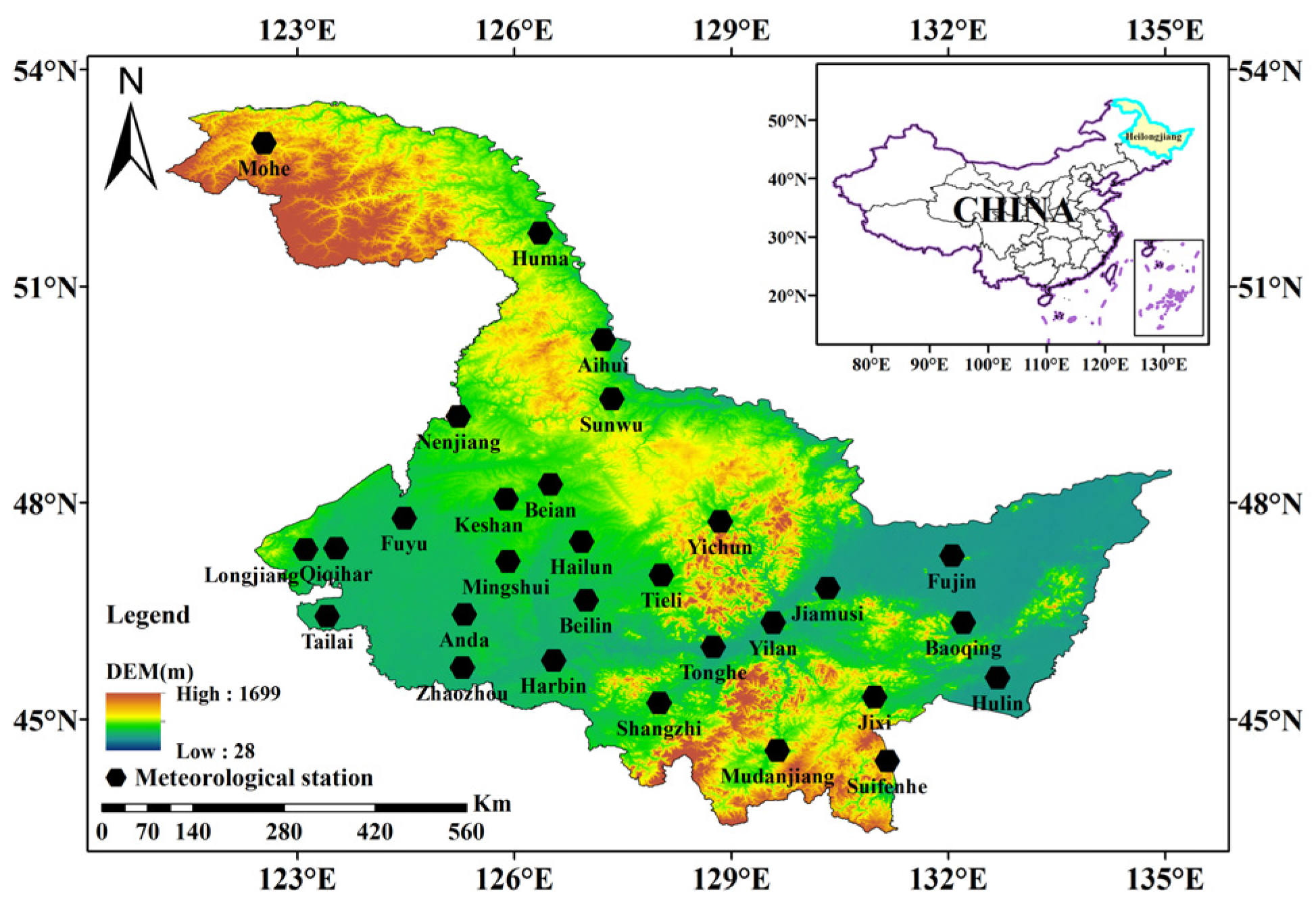
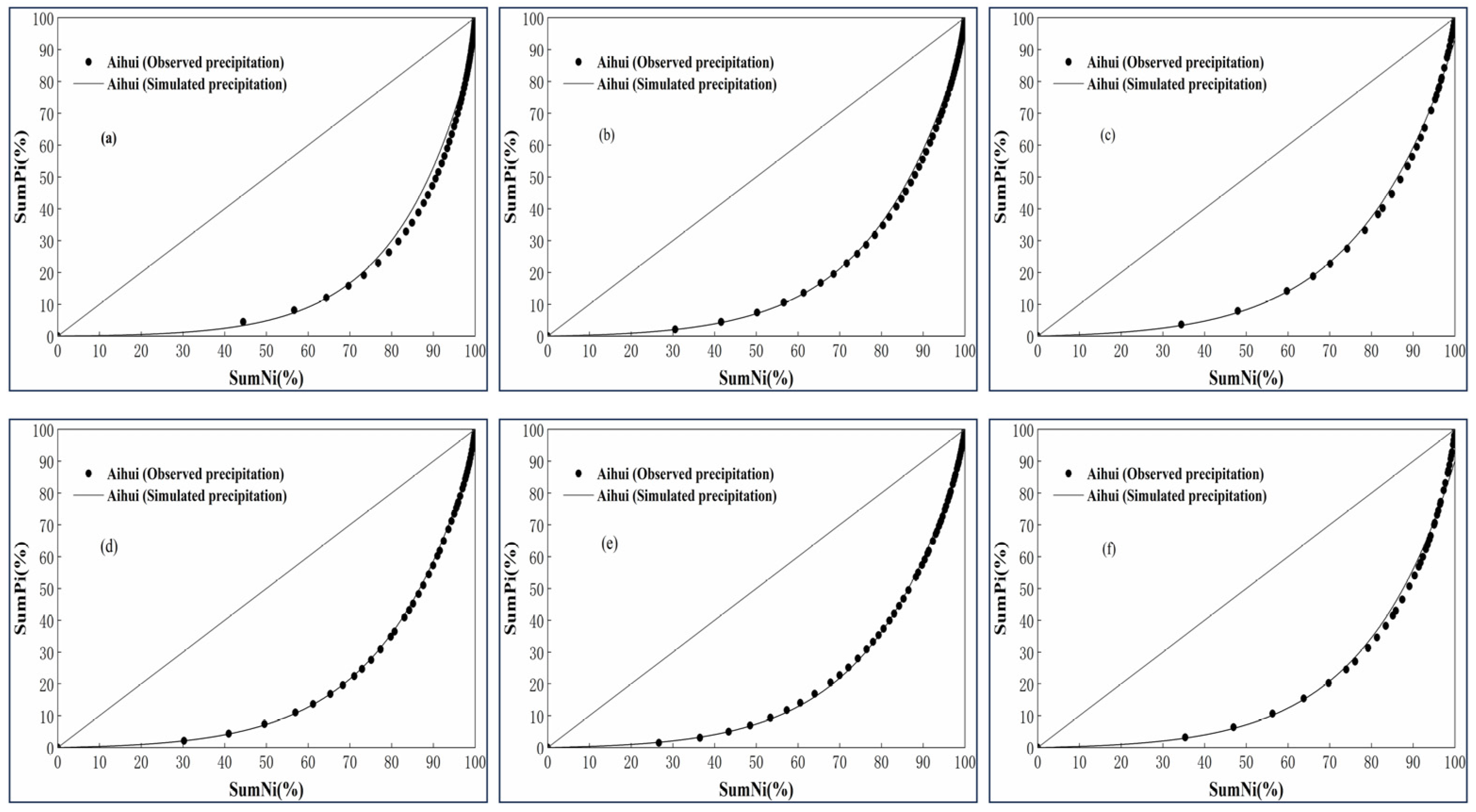
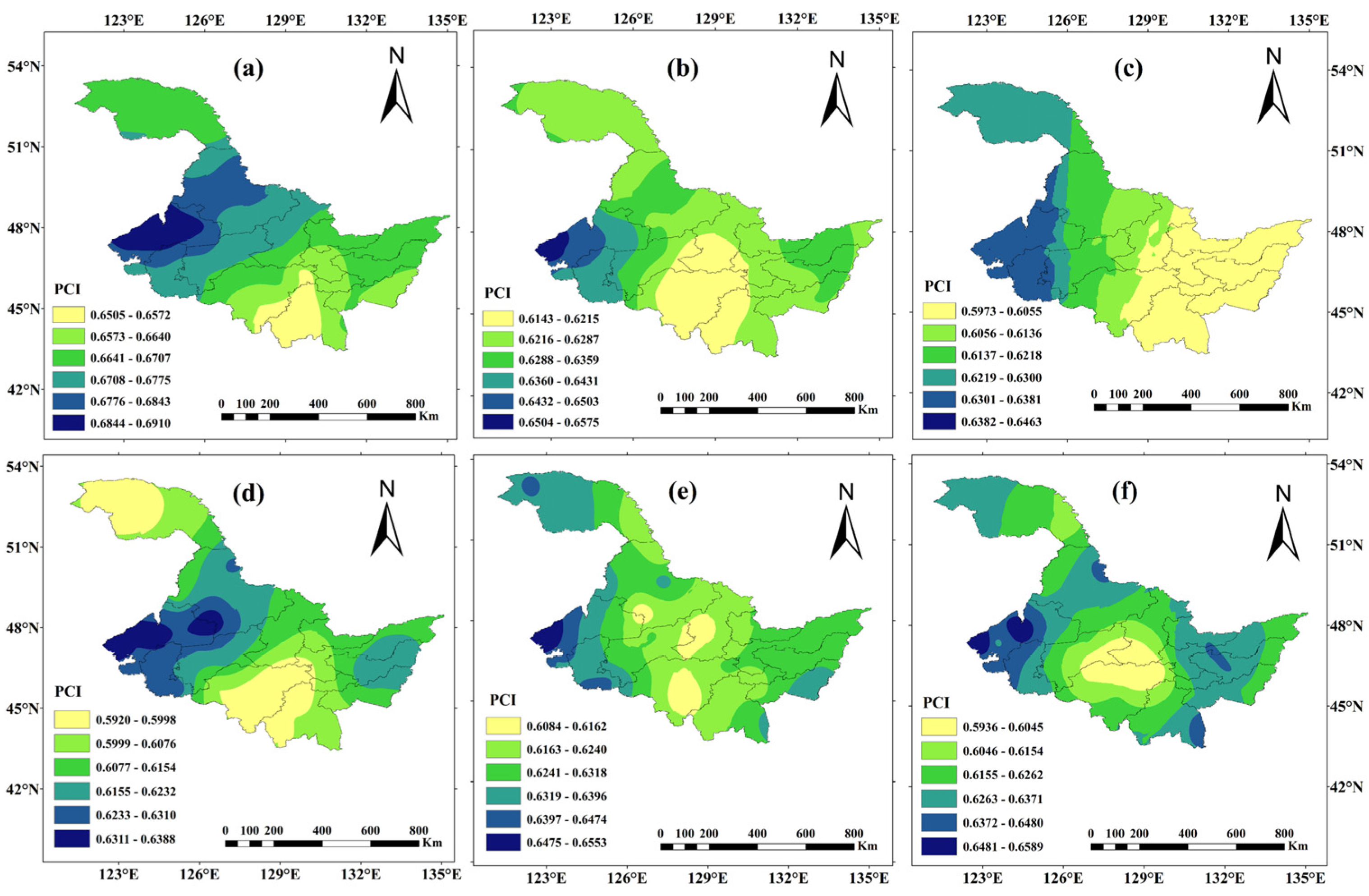
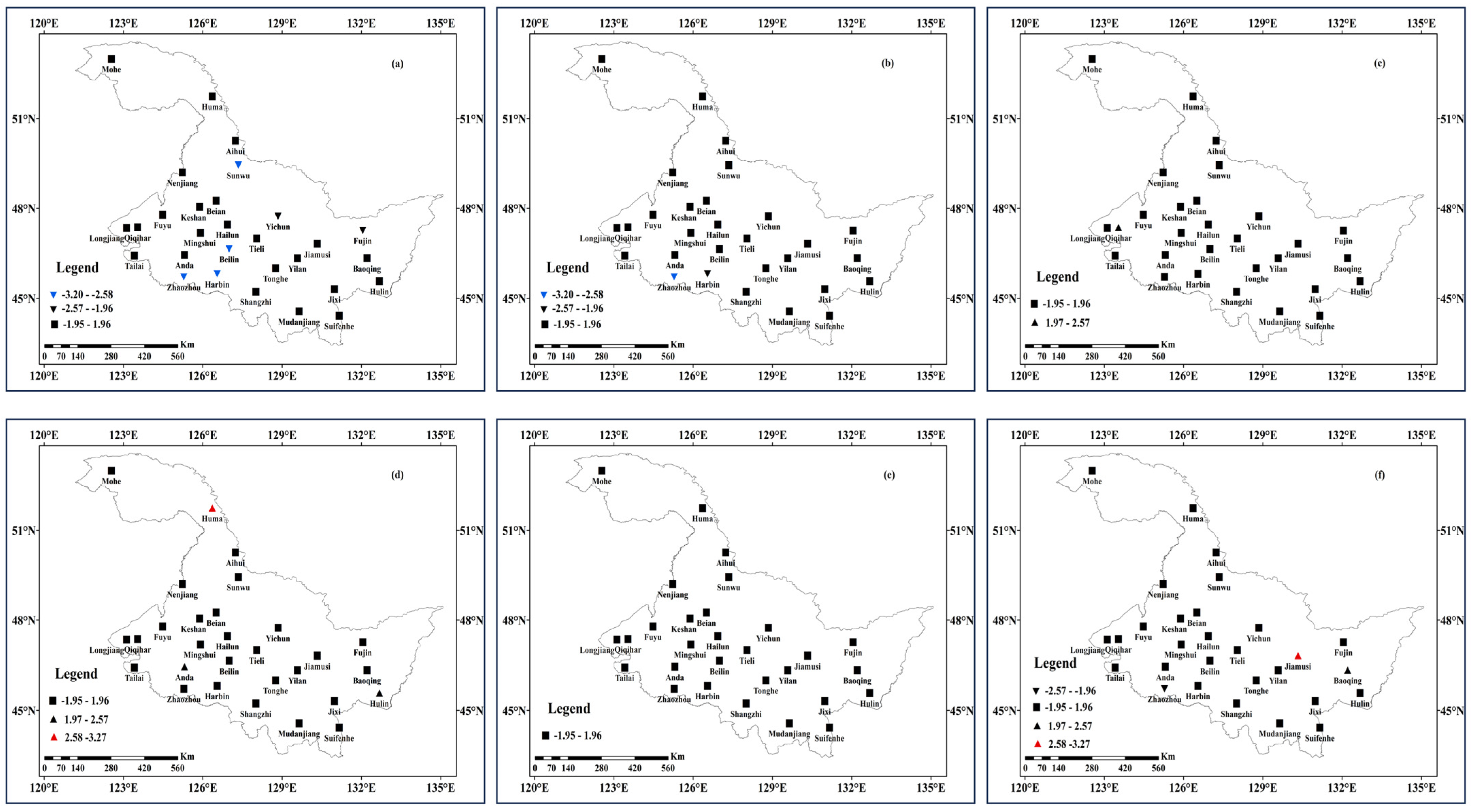
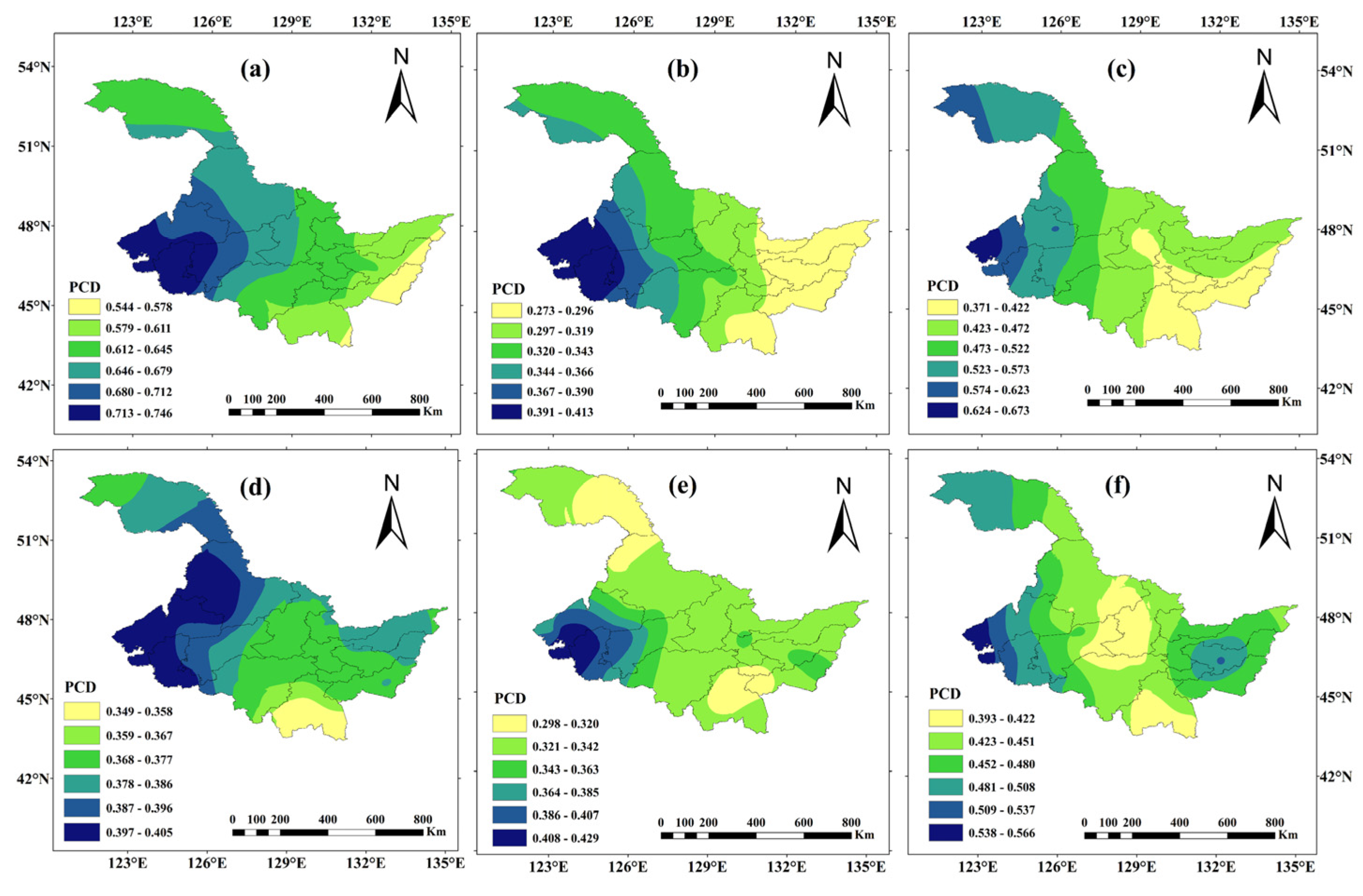
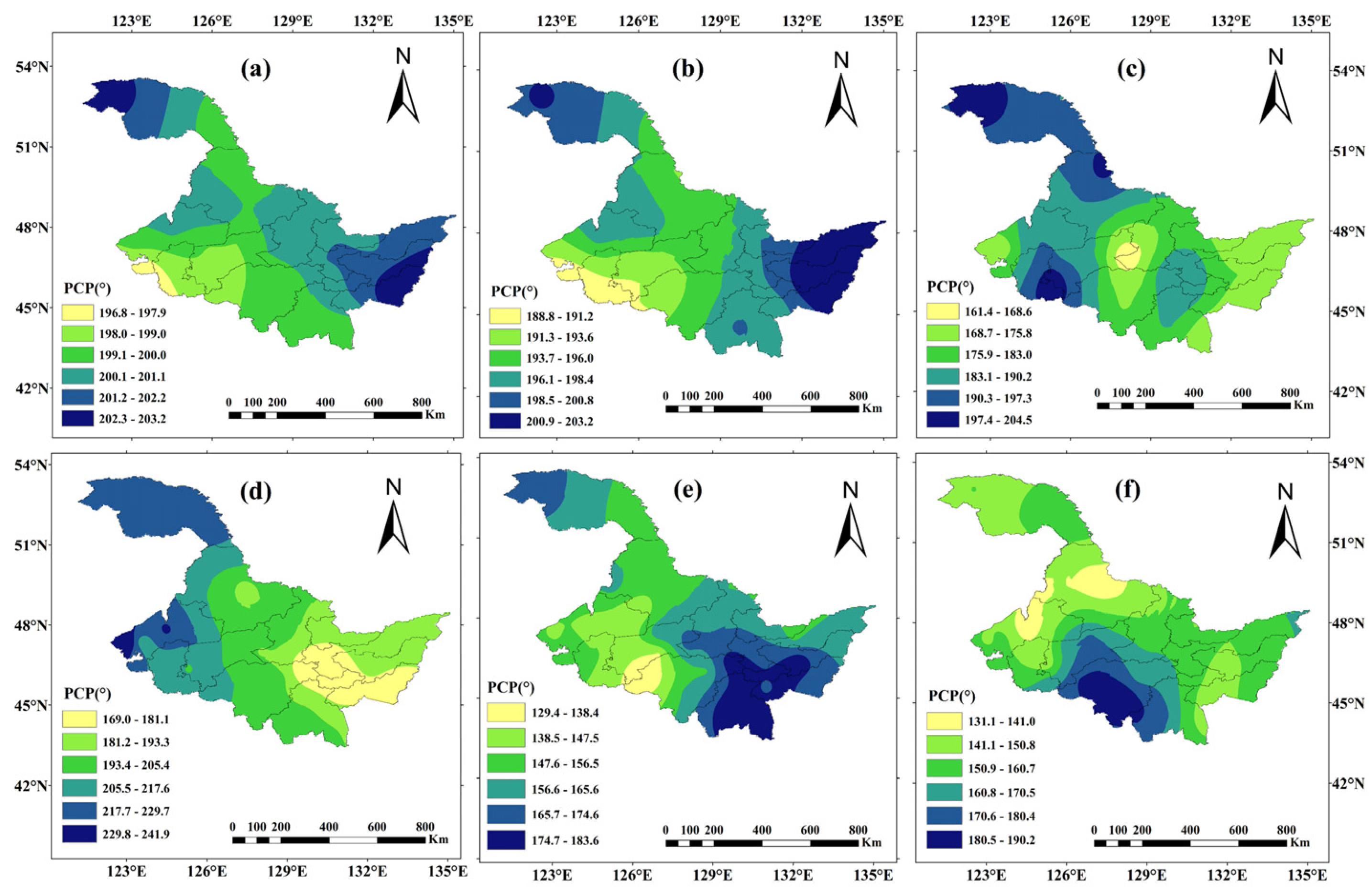
| Month | January | February | March | April | May | June |
| θ(°) | 15 | 45 | 75 | 105 | 135 | 165 |
| Month | July | August | September | October | November | December |
| θ(°) | 195 | 225 | 255 | 285 | 315 | 345 |
| Month | May | June | July | ||||||
| time | first | mid | last | first | mid | last | upper | mid | last |
| θ(°) | 12 | 36 | 60 | 84 | 108 | 132 | 156 | 180 | 204 |
| Month | August | September | |||||||
| time | first | mid | last | first | mid | last | |||
| θ(°) | 228 | 252 | 276 | 300 | 324 | 348 | |||
| Day | 1 | 2 | 3 | 4 | 5 | 6 | 7 | 8 |
|---|---|---|---|---|---|---|---|---|
| θ(°) | 6 | 18 | 30 | 42 | 54 | 66 | 78 | 90 |
| Day | 9 | 10 | 11 | 12 | 13 | 14 | 15 | 16 |
| θ(°) | 102 | 114 | 126 | 138 | 150 | 162 | 174 | 186 |
| Day | 17 | 18 | 19 | 20 | 21 | 22 | 23 | 24 |
| θ(°) | 198 | 210 | 222 | 234 | 246 | 258 | 270 | 282 |
| Day | 25 | 26 | 27 | 28 | 29 | 30 | ||
| θ(°) | 294 | 306 | 318 | 330 | 342 | 354 |
| Aihui | Year | Growth Period | Seeding–Emergence Stage | Emergence–Jointing Stage | Tasseling–Milky Stage | Mature Stage |
|---|---|---|---|---|---|---|
| a | 0.0100 | 0.0209 | 0.0298 | 0.0233 | 0.0226 | 0.0227 |
| b | 0.0453 | 0.0382 | 0.0344 | 0.0375 | 0.0375 | 0.0368 |
| PCI | 0.6809 | 0.6302 | 0.6104 | 0.6261 | 0.6206 | 0.6405 |
| Station Name | Station Number | Annual PCI | PCI in Growth Period | PCI in Seeding–Emergence Stage | PCI in Emergence–Jointing Stage | PCI in Tasseling–Milky Stage | PCI in Mature Stage |
|---|---|---|---|---|---|---|---|
| Aihui | 50468 | 0.6809 | 0.6302 | 0.6104 | 0.6261 | 0.6206 | 0.6405 |
| Anda | 50854 | 0.6714 | 0.6363 | 0.6388 | 0.6203 | 0.6320 | 0.6249 |
| Baoqing | 50888 | 0.6678 | 0.6266 | 0.5971 | 0.6217 | 0.6248 | 0.6383 |
| Beian | 50656 | 0.6768 | 0.6273 | 0.6143 | 0.6380 | 0.6078 | 0.6241 |
| Beilin | 50853 | 0.6714 | 0.6241 | 0.6145 | 0.6176 | 0.6206 | 0.5984 |
| Fujin | 50788 | 0.6667 | 0.6327 | 0.6239 | 0.6140 | 0.6312 | 0.6358 |
| Fuyu | 50742 | 0.6911 | 0.6473 | 0.6495 | 0.6357 | 0.6361 | 0.6614 |
| Harbin | 50953 | 0.6664 | 0.6232 | 0.6045 | 0.5999 | 0.6291 | 0.6069 |
| Hailun | 50756 | 0.6754 | 0.6336 | 0.6327 | 0.6242 | 0.6259 | 0.6182 |
| Huma | 50353 | 0.6662 | 0.6230 | 0.6164 | 0.6090 | 0.6200 | 0.6106 |
| Hulin | 50983 | 0.6601 | 0.6289 | 0.6064 | 0.6140 | 0.6381 | 0.6247 |
| Jixi | 50978 | 0.6633 | 0.6231 | 0.6128 | 0.6055 | 0.6213 | 0.6262 |
| Jiamusi | 50873 | 0.6600 | 0.6216 | 0.6017 | 0.6011 | 0.6242 | 0.6331 |
| Keshan | 50658 | 0.6855 | 0.6398 | 0.6484 | 0.6333 | 0.6246 | 0.6318 |
| Mingshui | 50758 | 0.6798 | 0.6363 | 0.6499 | 0.6240 | 0.6235 | 0.6170 |
| Mohe | 50136 | 0.6652 | 0.6264 | 0.6130 | 0.5925 | 0.6403 | 0.6265 |
| Mudanjiang | 54094 | 0.6503 | 0.6209 | 0.6071 | 0.6005 | 0.6219 | 0.6229 |
| Nenjiang | 50557 | 0.6795 | 0.6283 | 0.5934 | 0.6101 | 0.6382 | 0.6230 |
| Qiqihar | 50745 | 0.6867 | 0.6497 | 0.6614 | 0.6314 | 0.6479 | 0.6299 |
| Shangzhi | 50968 | 0.6577 | 0.6150 | 0.5965 | 0.5937 | 0.6106 | 0.6192 |
| Suifenhe | 54096 | 0.6654 | 0.6248 | 0.6082 | 0.6013 | 0.6342 | 0.6450 |
| Sunwu | 50564 | 0.6793 | 0.6323 | 0.6042 | 0.6157 | 0.6362 | 0.6360 |
| Tailai | 50844 | 0.6738 | 0.6397 | 0.6262 | 0.6245 | 0.6393 | 0.6411 |
| Tieli | 50862 | 0.6704 | 0.6156 | 0.5767 | 0.6112 | 0.6151 | 0.5929 |
| Tonghe | 50963 | 0.6656 | 0.6143 | 0.5933 | 0.5920 | 0.6182 | 0.5956 |
| Yichun | 50774 | 0.6744 | 0.6204 | 0.5899 | 0.6121 | 0.6119 | 0.6101 |
| Yilan | 50877 | 0.6562 | 0.6204 | 0.6076 | 0.5939 | 0.6250 | 0.5948 |
| Zhaozhou | 50950 | 0.6770 | 0.6410 | 0.6228 | 0.6268 | 0.6414 | 0.6337 |
| Longjiang | 50739 | 0.6864 | 0.6577 | 0.6657 | 0.6390 | 0.6554 | 0.6597 |
| Station Name | Station Number | Annual Z | Z in Growth Period | Z in Seeding–Emergence Stage | Z in Emergence–Jointing Stage | Z in Tasseling–Milky Stage | Z in Mature Stage |
|---|---|---|---|---|---|---|---|
| Aihui | 50468 | −0.76 | 0.36 | −0.48 | −0.43 | 1.08 | 0.62 |
| Anda | 50854 | −0.17 | 0.36 | 1.02 | 2.01 | −0.52 | −0.43 |
| Baoqing | 50888 | −0.81 | −0.12 | 0.07 | 0.66 | −0.34 | 1.98 |
| Beian | 50656 | −1.78 | −1.88 | −1.00 | 0.52 | −1.68 | −0.16 |
| Beilin | 50853 | −3.20 | −1.40 | −0.38 | −1.31 | 0.20 | 0.76 |
| Fujin | 50788 | −2.23 | −1.49 | −0.98 | −0.99 | −0.35 | 1.51 |
| Fuyu | 50742 | 0.30 | 1.12 | 0.95 | 1.22 | 1.80 | −1.21 |
| Harbin | 50953 | −3.03 | −2.48 | −1.75 | −0.73 | −0.96 | −0.20 |
| Hailun | 50756 | −1.51 | −0.50 | −0.78 | 0.11 | 0.85 | −0.96 |
| Huma | 50353 | 0.95 | 0.45 | 1.84 | 3.27 | −0.96 | −1.35 |
| Hulin | 50983 | −1.15 | −1.41 | −0.62 | 2.39 | −1.52 | −0.71 |
| Jixi | 50978 | −1.19 | −0.98 | −0.49 | −0.45 | −0.67 | 0.15 |
| Jiamusi | 50873 | −0.13 | −0.34 | −0.96 | 0.36 | −0.85 | 2.84 |
| Keshan | 50658 | −0.84 | −0.41 | −1.58 | 1.22 | −0.07 | −1.47 |
| Mingshui | 50758 | −0.31 | −0.38 | −0.04 | −1.22 | 0.24 | 0.71 |
| Mohe | 50136 | 0.61 | 0.47 | 0.10 | −0.29 | 0.77 | −0.17 |
| Mudanjiang | 54094 | 0.29 | 0.31 | −0.85 | 0.99 | 0.18 | −0.47 |
| Nenjiang | 50557 | −1.10 | 0.00 | −1.35 | 1.03 | 0.72 | −0.62 |
| Qiqihar | 50745 | 0.39 | 0.50 | 2.09 | 0.33 | 1.38 | 0.23 |
| Shangzhi | 50968 | −0.91 | −1.04 | 0.31 | −1.31 | −0.86 | 0.96 |
| Suifenhe | 54096 | 0.39 | 0.84 | 0.63 | 0.75 | −0.45 | −0.59 |
| Sunwu | 50564 | −2.86 | −1.55 | −0.68 | 0.31 | 0.01 | −1.88 |
| Tailai | 50844 | −0.27 | −0.01 | 1.44 | 0.41 | 0.91 | −1.84 |
| Tieli | 50862 | −1.74 | −0.40 | −0.66 | 0.38 | 0.62 | 0.24 |
| Tonghe | 50963 | −0.90 | 0.06 | 0.55 | −0.66 | 1.01 | 0.87 |
| Yichun | 50774 | −2.02 | −1.13 | −1.60 | −0.66 | −1.54 | 0.70 |
| Yilan | 50877 | −0.27 | −0.18 | −0.82 | −0.66 | −0.02 | 0.35 |
| Zhaozhou | 50950 | −3.06 | −2.69 | −1.58 | −0.49 | −1.91 | −2.32 |
| Longjiang | 50739 | −1.00 | −1.55 | −0.38 | −0.55 | −0.06 | −0.53 |
| Station Name | Station Number | Annual PCD | PCD in Growth Period | PCD in Seeding–Emergence Stage | PCD in Emergence–Jointing Stage | PCD in Tasseling–Milky Stage | PCD in Mature Stage |
|---|---|---|---|---|---|---|---|
| Aihui | 50468 | 0.670 | 0.327 | 0.478 | 0.389 | 0.325 | 0.424 |
| Anda | 50854 | 0.733 | 0.401 | 0.547 | 0.382 | 0.400 | 0.489 |
| Baoqing | 50888 | 0.614 | 0.286 | 0.432 | 0.351 | 0.346 | 0.515 |
| Beian | 50656 | 0.684 | 0.340 | 0.518 | 0.423 | 0.335 | 0.419 |
| Beilin | 50853 | 0.687 | 0.366 | 0.500 | 0.382 | 0.348 | 0.409 |
| Fujin | 50788 | 0.602 | 0.275 | 0.455 | 0.396 | 0.329 | 0.476 |
| Fuyu | 50742 | 0.707 | 0.403 | 0.574 | 0.393 | 0.399 | 0.492 |
| Harbin | 50953 | 0.662 | 0.356 | 0.483 | 0.376 | 0.353 | 0.478 |
| Hailun | 50756 | 0.689 | 0.331 | 0.494 | 0.383 | 0.361 | 0.461 |
| Huma | 50353 | 0.641 | 0.328 | 0.512 | 0.390 | 0.303 | 0.427 |
| Hulin | 50983 | 0.544 | 0.273 | 0.371 | 0.388 | 0.341 | 0.463 |
| Jixi | 50978 | 0.613 | 0.295 | 0.399 | 0.394 | 0.297 | 0.469 |
| Jiamusi | 50873 | 0.613 | 0.300 | 0.424 | 0.367 | 0.347 | 0.460 |
| Keshan | 50658 | 0.704 | 0.368 | 0.577 | 0.396 | 0.346 | 0.442 |
| Mingshui | 50758 | 0.723 | 0.378 | 0.541 | 0.381 | 0.398 | 0.461 |
| Mohe | 50136 | 0.625 | 0.336 | 0.578 | 0.368 | 0.332 | 0.497 |
| Mudanjiang | 54094 | 0.603 | 0.289 | 0.407 | 0.332 | 0.315 | 0.407 |
| Nenjiang | 50557 | 0.690 | 0.367 | 0.530 | 0.401 | 0.324 | 0.493 |
| Qiqihar | 50745 | 0.719 | 0.411 | 0.641 | 0.420 | 0.414 | 0.527 |
| Shangzhi | 50968 | 0.611 | 0.338 | 0.459 | 0.367 | 0.325 | 0.438 |
| Suifenhe | 54096 | 0.581 | 0.294 | 0.401 | 0.345 | 0.336 | 0.425 |
| Sunwu | 50564 | 0.657 | 0.331 | 0.487 | 0.399 | 0.338 | 0.433 |
| Tailai | 50844 | 0.730 | 0.404 | 0.596 | 0.405 | 0.430 | 0.547 |
| Tieli | 50862 | 0.663 | 0.332 | 0.437 | 0.362 | 0.327 | 0.393 |
| Tonghe | 50963 | 0.641 | 0.314 | 0.442 | 0.379 | 0.334 | 0.427 |
| Yichun | 50774 | 0.654 | 0.314 | 0.416 | 0.362 | 0.324 | 0.403 |
| Yilan | 50877 | 0.636 | 0.329 | 0.420 | 0.380 | 0.322 | 0.425 |
| Zhaozhou | 50950 | 0.719 | 0.386 | 0.543 | 0.421 | 0.381 | 0.483 |
| Longjiang | 50739 | 0.746 | 0.413 | 0.674 | 0.387 | 0.380 | 0.566 |
| Station Name | Station Number | Annual PCP (°) | PCP in Growth Period (°) | PCP in Seeding–Emergence Stage (°) | PCP in Emergence–Jointing Stage (°) | PCP in Tasseling–Milky Stage (°) | PCP in Mature Stage (°) |
|---|---|---|---|---|---|---|---|
| Aihui | 50468 | 199.5 | 191.9 | 199.2 | 206.7 | 152.0 | 143.4 |
| Anda | 50854 | 198.8 | 192.1 | 199.2 | 204.2 | 145.9 | 138.1 |
| Baoqing | 50888 | 201.9 | 209.7 | 176.1 | 184.7 | 185.2 | 147.0 |
| Beian | 50656 | 200.2 | 203.0 | 186.6 | 201.6 | 142.9 | 155.3 |
| Beilin | 50853 | 198.8 | 188.5 | 184.5 | 199.6 | 136.7 | 174.0 |
| Fujin | 50788 | 200.9 | 200.4 | 170.3 | 186.5 | 152.4 | 149.8 |
| Fuyu | 50742 | 200.2 | 202.3 | 189.6 | 232.7 | 144.3 | 131.0 |
| Harbin | 50953 | 198.6 | 191.8 | 188.8 | 211.0 | 128.4 | 183.1 |
| Hailun | 50756 | 199.0 | 193.9 | 183.2 | 199.4 | 164.1 | 174.3 |
| Huma | 50353 | 199.1 | 194.1 | 196.3 | 225.0 | 147.6 | 155.5 |
| Hulin | 50983 | 203.2 | 203.0 | 170.3 | 174.0 | 167.9 | 153.5 |
| Jixi | 50978 | 200.9 | 192.1 | 180.9 | 176.2 | 172.9 | 149.2 |
| Jiamusi | 50873 | 201.1 | 197.2 | 187.8 | 175.5 | 171.9 | 153.1 |
| Keshan | 50658 | 200.0 | 198.4 | 188.8 | 211.3 | 139.6 | 152.4 |
| Mingshui | 50758 | 198.9 | 187.2 | 185.2 | 217.5 | 146.0 | 168.0 |
| Mohe | 50136 | 202.6 | 203.8 | 204.6 | 219.3 | 170.7 | 151.1 |
| Mudanjiang | 54094 | 199.7 | 204.7 | 184.3 | 199.7 | 183.1 | 176.6 |
| Nenjiang | 50557 | 200.7 | 199.9 | 184.5 | 210.9 | 161.4 | 139.5 |
| Qiqihar | 50745 | 199.3 | 193.0 | 171.7 | 209.6 | 148.5 | 161.3 |
| Shangzhi | 50968 | 199.5 | 193.2 | 174.8 | 195.3 | 159.5 | 194.3 |
| Suifenhe | 54096 | 199.7 | 193.3 | 169.4 | 190.6 | 181.7 | 141.9 |
| Sunwu | 50564 | 199.9 | 191.7 | 192.6 | 189.6 | 148.9 | 127.2 |
| Tailai | 50844 | 196.8 | 183.7 | 178.1 | 222.4 | 155.4 | 160.1 |
| Tieli | 50862 | 200.0 | 196.7 | 161.1 | 192.3 | 169.8 | 168.3 |
| Tonghe | 50963 | 199.5 | 193.9 | 176.7 | 198.0 | 154.0 | 160.5 |
| Yichun | 50774 | 200.7 | 194.1 | 171.8 | 200.3 | 162.5 | 153.1 |
| Yilan | 50877 | 200.3 | 199.1 | 190.1 | 168.8 | 179.9 | 170.0 |
| Zhaozhou | 50950 | 198.4 | 189.8 | 202.5 | 207.4 | 140.6 | 169.8 |
| Longjiang | 50739 | 199.4 | 192.0 | 173.6 | 242.0 | 145.7 | 143.2 |
Disclaimer/Publisher’s Note: The statements, opinions and data contained in all publications are solely those of the individual author(s) and contributor(s) and not of MDPI and/or the editor(s). MDPI and/or the editor(s) disclaim responsibility for any injury to people or property resulting from any ideas, methods, instructions or products referred to in the content. |
© 2023 by the authors. Licensee MDPI, Basel, Switzerland. This article is an open access article distributed under the terms and conditions of the Creative Commons Attribution (CC BY) license (https://creativecommons.org/licenses/by/4.0/).
Share and Cite
Meng, F.; Sun, Z.; Dong, F.; Jiang, Y.; Zhang, H.; Zheng, E.; Li, T.; Yang, L. Spatiotemporal Evolution of Precipitation Heterogeneity Characteristics in the Heilongjiang Province from 1961 to 2020. Agronomy 2023, 13, 3057. https://doi.org/10.3390/agronomy13123057
Meng F, Sun Z, Dong F, Jiang Y, Zhang H, Zheng E, Li T, Yang L. Spatiotemporal Evolution of Precipitation Heterogeneity Characteristics in the Heilongjiang Province from 1961 to 2020. Agronomy. 2023; 13(12):3057. https://doi.org/10.3390/agronomy13123057
Chicago/Turabian StyleMeng, Fanxiang, Zhimin Sun, Fangli Dong, Yan Jiang, Hengfei Zhang, Ennan Zheng, Tianxiao Li, and Long Yang. 2023. "Spatiotemporal Evolution of Precipitation Heterogeneity Characteristics in the Heilongjiang Province from 1961 to 2020" Agronomy 13, no. 12: 3057. https://doi.org/10.3390/agronomy13123057
APA StyleMeng, F., Sun, Z., Dong, F., Jiang, Y., Zhang, H., Zheng, E., Li, T., & Yang, L. (2023). Spatiotemporal Evolution of Precipitation Heterogeneity Characteristics in the Heilongjiang Province from 1961 to 2020. Agronomy, 13(12), 3057. https://doi.org/10.3390/agronomy13123057






